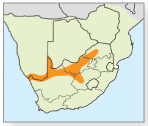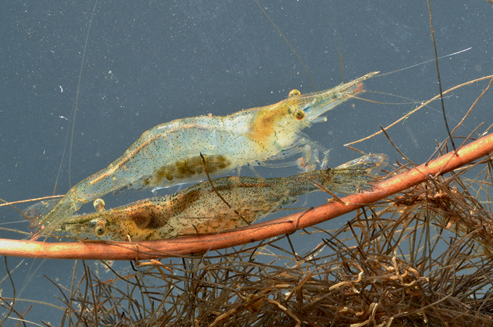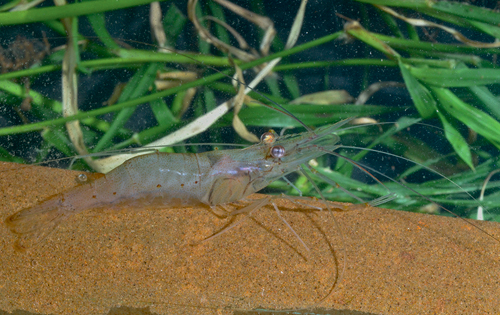
18 |
Text by Savel Daniels |
|---|---|
Crabs, prawns and crayfish
Order Decapoda
This diverse group comprises about 15,000 species of 10-legged crustaceans and includes most of the larger, more familiar forms, such as the crabs, lobsters, shrimps, prawns and hermit crabs.
Crabs
Infraorder Brachyura
Body short, rectangular and flattened, covered by a hard ‘shell’ or carapace; abdomen reduced and folded under body – triangular in males, semicircular in females; one pair of stalked eyes and five pairs of walking legs, first pair modified to form sturdy pincers (chelipeds). Freshwater crabs may disperse overland between water bodies, but depend on fresh water for reproduction. Large yolk-rich eggs develop under the abdomen of females and hatch into juvenile crabs, without a dispersive larval stage. Diet omnivorous, comprising decaying plant and animal matter. Are very important prey items in diets of birds, fish and otters, and can be vectors for disease, such as lung flukes and river blindness in humans. The southern African fauna comprises 23 described species, all in the genus Potamonautes.
1 Spiked mountain river crab
Potamonautes parvispina


© C. GRIFFITHS
Carapace brown, with a single small lateral tooth. Right cheliped highly arched. Size: Small-bodied, carapace up to 29mm in length. Biology: Found in fast-flowing, boulder-strewn mountain streams of the Western Cape. RELATED SPECIES: In P. brincki (Hottentots Holland Mountains) the anterolateral margin is smooth. The related P. parvicorpus (Table and Jonkershoek mountains) is similar, but has slightly different mouthparts. P. clarus (northern Drakensberg Mountains) also has a smooth anterolateral margin, but carapace is bright orange and chelipeds are highly arched. The related P. depressus (southern Drakensberg Mountains) has a brown carapace and also highly arched chelipeds.
2 Burrowing freshwater crab
Potamonautes calcaratus


© C. GRIFFITHS
Single tooth on front of carapace, ridge at anterolateral margin is incomplete and carapace highly vaulted. Right claw highly modified and nearly flat (‘spade-like’) as an adaptation for burrowing. Size: Carapace up to 40mm in length. Biology: A semiterrestrial species, constructing deep single-entry burrows around ephemeral pans. During dry season crabs burrow until they reach the water table. Terminal portion of burrow generally round and filled with water to keep the gills moist, allowing for uptake of oxygen.
3 Swamp forest freshwater crab
Potamonautes lividus


© W. EMMERSON
Semiterrestrial species with vaulted orange to red carapace with silver-blue sheen. Margins of carapace smooth at the front. Chelipeds bright red-orange. Size: Carapace up to 28mm in length. Biology: Restricted to swamp forests, where it forms shallow U-shaped burrows in hydromorphic peat soil. Listed as Vulnerable by IUCN, owing to its highly localised distribution.
4 Cape river crab
Potamonautes perlatus


© C. GRIFFITHS
Anterolateral margin of carapace smooth; top surface of body frequently covered in hair-like structures. Size: Carapace up to 47mm in length. Biology: Widely distributed and found under boulders in large rivers and streams, or sometimes roaming overland between rivers. Recent genetic research suggests three genetically distinct groups are present within this species.
5 Sidney’s river crab
Potamonautes sidneyi


© G. GIRIBET
Carapace granulated at anterolateral margin, with pronounced rough surface. Size: Carapace up to 66mm in length. Biology: Common in boulder-strewn streams and rivers. Can migrate overland in very moist conditions, particularly after heavy summer rains. Females carry up to 900 eggs under abdomen; eggs take up to three months to hatch into juvenile crabs.
6 Warren’s river crab
Potamonautes warreni


© C. GRIFFITHS
Anterolateral margin of carapace has series of prominent spines. Size: Carapace up to 50mm in length. Biology: Very common in large rivers. Widely used as a model in ecotoxicologial studies in South Africa to examine the levels of heavy metals in freshwater systems. SIMILAR SPECIES: P. unispinus has a single, sharp, prominent spine on anterolateral margin of carapace and attains 56mm in length; it has a wide distribution, ranging from the Vaal River and its major tributaries in South Africa, northwards to the Democratic Republic of the Congo.
Prawns, shrimps and crayfish
Infraorders Caridea and Astacidea
Body divided into two sections; a combined head and thorax (cephalothorax) bearing one set of eyes, two pairs of elongated antennae and five pairs of slender elongate legs, the first two pairs usually equipped with pincers (chelae). This is followed by an elongate fleshy abdomen ending in a tail fan. Move both by swimming and walking. Three indigenous freshwater shrimp and prawn genera occur in southern Africa, plus several crayfish introduced for their potential for aquaculture, but which have escaped and established wild populations.
1 Freshwater shrimp
Caridina nilotica


© C. GRIFFITHS
Wrist of first leg not deeply excavated; apical portion of rostrum dorsally smooth, rostrum as long as, or a little longer than, carapace. Size: Body up to 30mm in length. Biology: Can be filter feeders, collector-gatherers or omnivorous scavengers. Found in rivers, streams and stagnant water. Abundant from KwaZulu-Natal into the African Great Lakes, where they are an important forage species for predatory fishes and undergo daily vertical migration between bottom and surface. RELATED SPECIES: C. typus has wrist of first leg deeply excavated and whole upper margin of rostrum smooth; body attains 41mm in length. Found in coastal drainages in KwaZulu-Natal.
2 Hairy (furry-armed) river prawn
Macrobrachium rude


© C. GRIFFITHS
Elongated and enlarged second leg and claw covered by fine setae, cutting edges of finger and claw with marked rows of tubercles; lower margin of rostrum with 3–5 teeth. Size: Body up to 112mm in length. Biology: Frequently found in fresh and brackish water along entire East African coast, as well as Madagascar and India. Cultivated in coastal areas as a source of food. RELATED SPECIES: One of seven species of Macrobrachium in region. M. equidens (KwaZulu-Natal) is similar, but found mostly in estuaries; only the last segments of the claw are hairy, and ventral margin of rostrum has 5–7 teeth.
3 Freshwater shrimp
Palaemon capensis


© C. GRIFFITHS
Rostrum straight, with gently and evenly convex dorsal and ventral profile; wrist of second leg nearly as long as chela; outer branch of antenna 1 very short. Size: Body up to 66mm in length. Biology: Lives in fresh and brackish waters and migrates to estuaries in the spring to breed. Seems to prefer the peat-stained waters of rivers.
4 Australian red claw crayfish
Cherax quadricarinatus


© C. GRIFFITHS
Dark brown to blue-green; adult male with distinct red patch on outer margin of claw and four crests on carapace behind rostrum. Size: Body >250mm in length. Biology: An alien species in southern Africa. Omnivorous and an aggressive invader. Can also destroy living large plants. At present localised in distribution. Introduced from Australia for aquaculture in Swaziland, but escaped and established breeding colony in Ndumu Game Reserve, KwaZulu-Natal. The escaped population is infected with a flatworm parasite that might spread to indigenous freshwater crabs and prawns. More recently also collected around Lake Kariba, where it is becoming a serious pest after escaping from fish farms in Zambia.
5 Marron
Cherax tenuimanus


© C. GRIFFITHS
Robust species with a distinct ridge running backwards from a spine behind each eye. Rostrum has serrations on each side, ending in a sharp spine. Size: Body can reach 400mm in length and weigh 2.5kg under aquaculture conditions. Biology: Prefers sandy bottoms of rivers and dams. First introduced in the 1980s from Australia, feral populations appear to be highly localised in distribution, but can cause major impacts on benthic ecology, including reduced fish recruitment. Also known to be a disease vector, hosting flatworms, fungi and bacteria. RELATED SPECIES: Procambarus clarkii (Red swamp crayfish) exhibits high variability in colour (depending on habitat), with white, blue or orange being most common; has wedge-shaped black stripe on abdomen. Very hardy and can survive in polluted systems. A destructive burrower; can attain 120mm in length. Although importation is banned, animals have escaped from illegally imported populations to infest the Crocodile River.